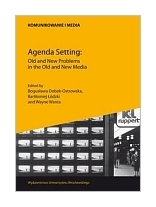|

AGENDA SETTING OLD AND NEW PROBLEMS IN THE OLD AND NEW MEDIA
DOBEK-OSTROWSKA B. ŁÓDZKI B. WAYNE W. wydawnictwo: WYD UN WROCŁAW , rok wydania 2012, wydanie I cena netto: 29.60 Twoja cena 28,12 zł + 5% vat - dodaj do koszyka Agenda Setting Old and New problems in the Old and New Media
Editors’ introduction (Bogusława Dobek-Ostrowska, Bartłomiej Łódzki, Wayne Wanta)
Chapter 1: The Internet as a tool in agenda setting research (Wayne
Wanta)
Internet
First-level and second-level agenda setting
News reading patterns on the Internet
Methodological concerns
The Internet as media content
The Internet as public
The Internet as an intervening variable
Conclusion
Chapter 2: Refining agenda setting theory for 21st century media and communication
research: Setting the new media research agenda (Amira Firdaus)
Introduction: The call for theory-building in agenda setting
Agenda setting theory and the underlying media environment
Studying salience-transfer in a user-driven media context
Recent literature on new media and journalism
Agenda setting in user-driven news contexts
Transferring “salience-transfer”: beyond the effects paradigm
Salience-transfer and “interpretive repertoires”
Salience-transfer of news narratives
New research methods
Conclusion
Chapter 3: Agenda setting and international news: Attributes and national images
(Wayne Wanta)
The agenda setting tradition
The five branches of agenda setting
Links to international news research
Potential applications
Chapter 4: The individual as an active subject related to agenda setting
(Sergün Kurtoglu)
Introduction
Literature review
Priming, framing, first-level and second-level agenda setting
What type of public agenda?
Which form of media agenda?
A suggestion regarding the relationship between the individuals and the media agenda on
the basis of perceptive grouping
Let us further explain the aforementioned three variable wholes
Conclusion
Chapter 5: The media role on the public engagement into foreign policy
(Milda Celiešiute)
Introduction
The media and public and foreign policy decision making: linking the communication chain
Testing the communication chain: the prerequisites for the media’s and public influence
on Lithuanian foreign policy decisions
Public opinion sources used by foreign policy officials
Conclusions
Chapter 6: Politicking from the pulpit: 20th century popes as agenda setters
(David P. Burns)
20th Century popes as agenda setters
The battle for relevance: framing politics in religious terms
Setting the agenda on life and labor: Pope Leo XIII’s Rerum Novarum
Priming the public: Pope John Paul II’s Laborem Exercems and Centesimus Annus
The popes and modern mass media: Pope Pius XII’s Miranda Prorsus, and Pope Paul VI’s
Vatican Council II’s Inter Mirifica
Conclusion
Chapter 7: A comparative analysis of raising religious topics in Central and
Western Europe (Imrich Gazda and Albert Kulla)
Introduction
Impact of new values on gatekeeping
Impacts of lines of editorship on gatekeeping
Impacts of preferences of authors on gatekeeping
Conclusion
Chapter 8: Methods of media coverage of famous people’s deaths at the turn of
the 21st century (Radosław Aksamit)
Introduction
Entertainment agenda — celebrity agenda. Analysis of factors causing it to occur and to
grow in strength
Other factors causing the issues of celebrities and celebrities’ deaths to gain strength
in the media agenda
Second level of agenda setting process — attributes of issues
Forming the vision of death? Jackson back on top
The problem of the neglected agenda
Circle conception and the point of saturation in agenda setting
Other elements that make the correlation between agendas decreasing
The wheel is spinning faster
Chapter 9: Learning from the screen: American media content, perceived realism,
and Polish viewers’ social perceptions (Maria A. Kopacz and Dana E. Mastro)
Introduction
Cultivation theory and international media effects
The present study
Method
Discussion
Chapter 10: The impact of social media on traditional media agenda setting theory
— the case study of the Occupy Wall Street movement in the USA (Ilona
Grzywińska and Jonathan Borden)
Introduction
Occupy Wall Street — overview of the case
Social media agenda building theory
Social media and agenda setting theory
The theory of the issue-attention cycle
Methodology
Discussion
Notes on contributors
Index
168 pages, Paperback
Księgarnia nie działa. Nie odpowiadamy na pytania i nie realizujemy zamówien. Do odwolania !.
|


